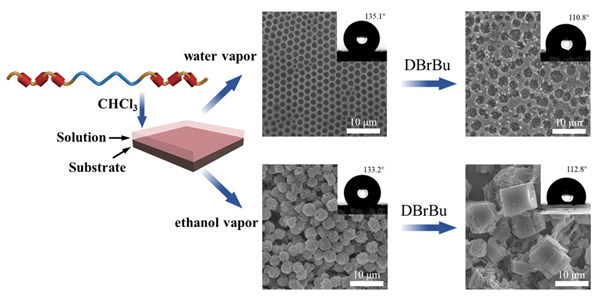摘要/Abstract

响应性薄膜能够响应外界的刺激来改变自身的结构或性能, 是智能材料的重要组成部分. 本工作以1,4-二乙氧基柱[5]芳烃(1,4-diethoxypillar[5]arene, DEP5A)和聚己内酯-b-聚乙二醇-b-聚己内酯(PCL-b-PEG-b-PCL)构建的准聚轮烷(polypseudorotaxane, PPR)为原料, 利用呼吸图法制备出了蜂窝状多孔及球状组装体的疏水薄膜. 研究发现溶剂、浓度、柱芳烃物质的量比和成膜气氛等因素对薄膜表面形貌均能产生较大的影响. 通过制膜条件的优化, 在水汽氛围中制备出了表面具有规则蜂窝状结构的多孔薄膜, 在乙醇氛围下制备出了表面为规整的褶皱球状组装体的薄膜. 研究表明, 上述两种具有规则表面形貌的PPR薄膜对竞争性客体1,4-二溴丁烷都具有响应性, 表现出薄膜表面形貌的变化及亲疏水性的变化. 此类响应性薄膜在微量液体无损转移、功能性涂层和智能薄膜等方面具有潜在的应用前景.
关键词: 准聚轮烷, 柱芳烃, 呼吸图法, 响应性薄膜, 疏水性
Stimuli-responsive film is an essential part of smart materials for its manipulation of structures or performances in response to external stimulations, which is crucial to the exploitation of actuators, sensors, and soft robotics. Herein, a novel polypseudorotaxane (PPR) with competitive guest-responsiveness was leveraged to fabricate polymer films with diverse surface morphologies via breath figure (BF) method under water or ethanol atmosphere. PPR was constructed based on the selective recognition of 1,4-diethoxypillar[5]arene (DEP5A) to the PCL block of polycaprolactone-block-poly(ethylene glycol)-block-polycaprolactone (PCL-b-PEG-b-PCL) in CHCl3. The morphologies of such polymer films were observed by scanning electron microscopy (SEM). Specifically, ordered honeycomb porous films with an average pore size of approximately 2.15 μm and sphere films with an average diameter of approximately 3.34 μm were fabricated via BF method under water atmosphere and ethanol atmosphere, respectively. The influences of solvent, concentration, and the equivalent ratio of DEP5A to PCL- b-PEG-b-PCL on the nanostructures of films were investigated. It was found that the films with ordered microstructures were obtained using PPR (15.0 equiv. of DEP5A to PCL-b-PEG-b-PCL, 5.0 mg?mL-1 of PCL-b-PEG-b-PCL) solution under a constant relative humidity of 90% or ethanol atmosphere at 25 ℃. These films showed hydrophobic (water contact angle over 130°) due to their hierarchical structures. Furthermore, the obtained films were immersed in competitive guest-containing solution (20.0 μL DBrBu+10.0 mL ethanol) to manipulate their structures and hydrophobicity. The competitive guest, 1,4-dibromobutane (DBrBu), showed stronger affinity than PCL block to DEP5A. DEP5A would be detached from the PCL block and form pseudorotaxane with DBrBu after immersing the films in competitive guest-containing solution. With the immersion time increasing, PPR were destroyed progressively, resulting in the formation of cuboid-crystal films and the decrement of water contact angle. This result provided a facile strategy to fabricate a smart film with controllable wettability and to explore the potential application prospects in the non-destructive transfer of trace liquids, functional coatings and smart film materials.
Key words: polypseudorotaxane, pillararene, breath figure method, responsive film, hydrophobicity
PDF全文下载地址:
点我下载PDF
